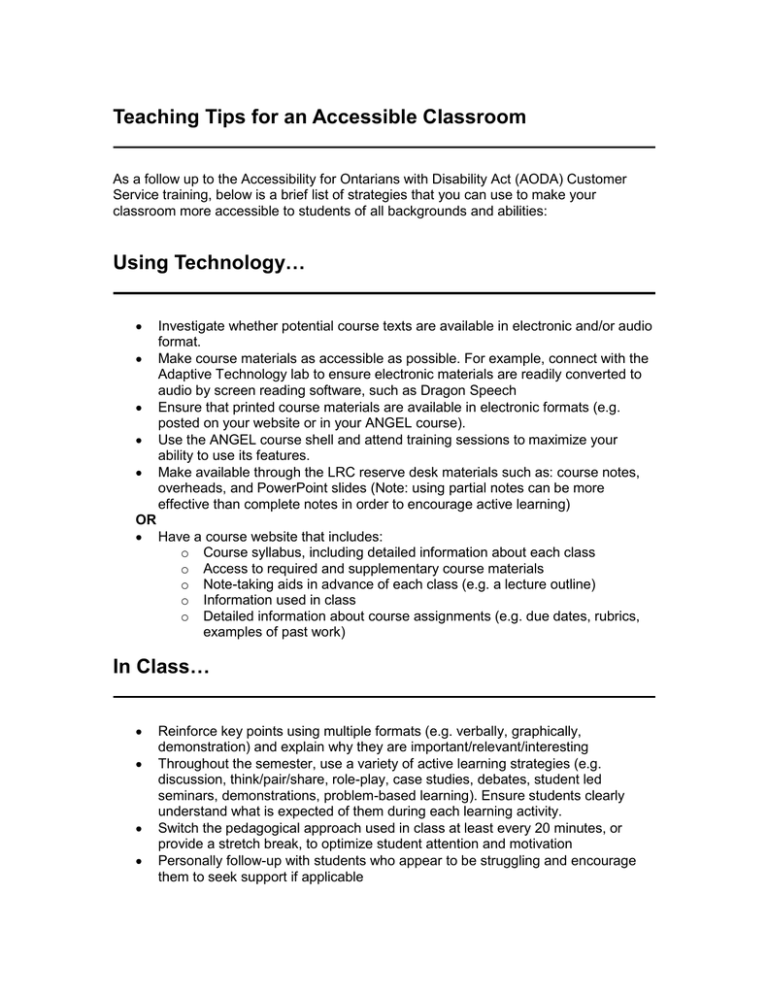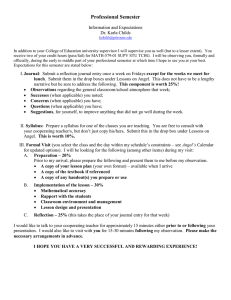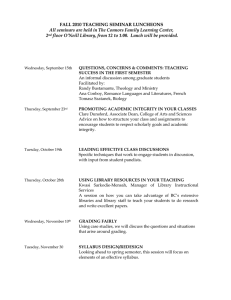Teaching Tips for an Accessible Classroom
advertisement

Teaching Tips for an Accessible Classroom As a follow up to the Accessibility for Ontarians with Disability Act (AODA) Customer Service training, below is a brief list of strategies that you can use to make your classroom more accessible to students of all backgrounds and abilities: Using Technology… OR Investigate whether potential course texts are available in electronic and/or audio format. Make course materials as accessible as possible. For example, connect with the Adaptive Technology lab to ensure electronic materials are readily converted to audio by screen reading software, such as Dragon Speech Ensure that printed course materials are available in electronic formats (e.g. posted on your website or in your ANGEL course). Use the ANGEL course shell and attend training sessions to maximize your ability to use its features. Make available through the LRC reserve desk materials such as: course notes, overheads, and PowerPoint slides (Note: using partial notes can be more effective than complete notes in order to encourage active learning) Have a course website that includes: o Course syllabus, including detailed information about each class o Access to required and supplementary course materials o Note-taking aids in advance of each class (e.g. a lecture outline) o Information used in class o Detailed information about course assignments (e.g. due dates, rubrics, examples of past work) In Class… Reinforce key points using multiple formats (e.g. verbally, graphically, demonstration) and explain why they are important/relevant/interesting Throughout the semester, use a variety of active learning strategies (e.g. discussion, think/pair/share, role-play, case studies, debates, student led seminars, demonstrations, problem-based learning). Ensure students clearly understand what is expected of them during each learning activity. Switch the pedagogical approach used in class at least every 20 minutes, or provide a stretch break, to optimize student attention and motivation Personally follow-up with students who appear to be struggling and encourage them to seek support if applicable Read key information presented on slides, blackboard, overheads etc. aloud to ensure effective communication to all, including those with visual impairments. Use open-ended questions to check for comprehension. Prior to calling on someone to respond, allow all students the opportunity to formulate a response by: 1. pausing – for a count of ten; 2. having students record their responses; or 3. having students share their responses with their neighbour(s). Setting Expectations… Establish ground rules for classroom and online behaviour and discussions that reinforce tolerance and respect. Begin the semester by identifying the learning objectives for your course. Present an agenda for the class (e.g. an overview of the learning activities and key concepts) and refer to it at key points during the class (particularly during transitions) Distribute a hardcopy of your course syllabus and ask students to review all of its elements. Ask questions about the content of the syllabus (e.g. course requirements, resources and policies) to check for comprehension and foster discussion Connect/help them to connect your stated learning objectives with what they already know, what they’ll learn in other courses and what they need to know for possible careers. Emphasize the course materials’ importance and relevance. Evaluation and Assessment... Use a variety of assessment activities (e.g. papers, learning journals, projects, presentations, tests, quizzes, oral exams) to allow/encourage multiple ways of demonstrating learning. Provide detailed grading criteria/rubrics at the beginning of an assignment (or have students help develop them) so students know exactly what is expected of them and can make informed decisions about their learning approach Have students assess their current skill level in areas of relevance to the course and record any concerns they might have for completing course work. Ask them to share this with you Create activities that provide students with the opportunity to develop learning skills in preparation for testing situations (e.g. review games that encourage integration of course concepts, spend time in class reviewing questions of a similar format to those that will be on the exam).







